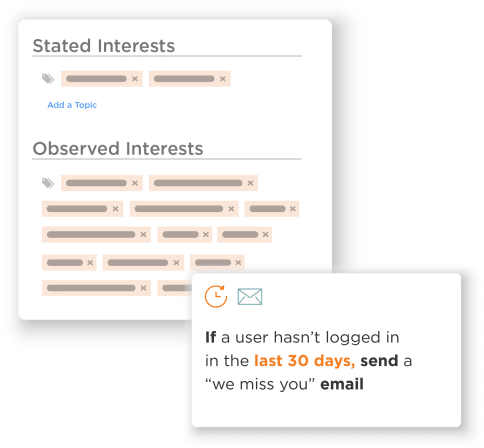The Ultimate Guide to Marketing Automation
Say hello to a more effective communication strategy for your association

Why Use Marketing Automation?
Today’s members are looking for communication tailored to their needs. In the Association Member Experience Report, 71% of association members told us that a personalized member experience is important to them.
Batch-and-blast, one-off emails to your entire member base aren’t enough to meet your member engagement and retention goals anymore. To be effective today, your communications strategy needs to deliver a personal and valuable experience for each member.

Marketing automation enables you to monitor and learn from your audience’s behavior and set up automated, responsive email workflows based on that data. This way you can deliver content that resonates with specific member segments while saving manual labor – it’s a win-win.
- Improve personalization and segmentation
- Optimize the timing of your communications
- Reduce manual work
- Improve your response to subscriber activity
- Enhance campaign cohesiveness, flow, continuity, and experience
- Measure the performance of a full campaign rather than manually reviewing each individual message
- Improve strategy scope without increasing labor costs
In this guide, we’ll walk through some key considerations and marketing automation strategies to help you succeed.
3 Critical Elements of Successful Marketing Automation
Marketing automation technology makes it easy to manage the segmenting, personalizing, and timing of your email outreach to deliver customized content that engages your audience. You can save time and create more effective marketing campaigns by automating certain triggers and repetitive tasks. For this to work, there are three elements of marketing automation you should keep in mind:
- Understanding your audience to create segments and personas
- Automated campaign structure and content
- Using data to connect with your audience
1. Understanding Your Audience: How Segments and Personas Work Together
In marketing, when we talk about creating value and relevancy (the key to marketing success), having a sense of who you're trying to reach and the most effective way to talk to them is key. That's where marketing personas and your member segments come into play.
Personas
Personas are research-based, fictional representations of your ideal members or target audience. Your organization’s personas shouldn’t just be a function of marketing – they should be developed and agreed upon by stakeholders organization-wide. That way, your personas drive everything from programs and benefits to customized content and personalized marketing messaging — delivering true value for the entire member journey. If you haven’t developed target personas or haven’t reviewed them recently, now is the time. You can have as many personas as you need, but we recommend starting with one or two, because it can get overwhelming quickly. It’s best to revisit these on a regular basis to expand and refresh as needed.
Learn How to Develop Personas >
Segments
An audience or member Segment is your actual email list, broken down into groups of real people, based on real data. For example, you could segment your members based on age, job title, membership level, etc. With the data you gather through marketing automation, you even can hyper-segment your list. Segments can bebased on more than just demographics: Behavior like clicks, time spent on specific webpage are great pieces of data to segment on.
Learn more about segmenting and personalizing >
2. Automated Marketing Campaign Structure and Content
Campaign Details
Ask yourself:
-What is the goal of the campaign and/or what action are you asking members to take?
-How are you defining success for this campaign?
-Who should get the campaign/what member segment(s)?
-How long should the campaign run?
-Is there a follow-up opportunity (abandoned action, resend to nonopeners, etc)?
-Should a sign-up form or landing page be part of the flow? If so, what is the URL?
Learn more about the nuts and bolts of automated campaigns >

3. Using Data to Connect with Your Audience
Sometimes the word “automation,” in marketing automation buries the real value of this method. Certainly, it’s helpful to save time by automating some of your work, but the real power of marketing automation lies in its ability to target your members with the messages that are most relevant to them when those messages will resonate most.
For that, you need data (check out our Member Data Success Kit for a deep dive).
While behavioral tracking, like web tracking, may not be the first thing that leaps to mind when you think about marketing automation, it should be top of mind. Ask yourself, what do I KNOW about my members or what data do I track that should be a trigger for communication? If someone joins a specific sub community on your online community, should they get a welcome email? When someone registers for your conference, should they be added to a campaign preparing them to attend? And what can you learn from members’ actions on your website and elsewhere?
Two types of tracking you can use to level-up your marketing automation:
Web Tracking
Web tracking is an insight and action tool built into Higher Logic Thrive Marketing to help you better understand and leverage visitor activity on your website. This capability can be a gamechanger for your organization as it allows you to customize outreach to your audience by acting on their unspoken needs. While Google Analytics helps you monitor traffic quantity, our web tracking tool tells you WHO from your mailing list is visiting what pages. For example, if someone has visited your certification page several times without applying, perhaps you want to automate a follow-up message checking in to see if they have questions. Or if someone has looked at your member benefits page, maybe you could follow up with a membership promotion.
Engagement Scoring
Engagement scoring is another tool built into Higher Logic Thrive Marketing where you can use behavior to sort recipients into lists or trigger follow-up. You may be familiar with the term “lead scoring,” which is a foundational concept for email marketing and sales. Lead scoring is a way for marketing and sales teams to automatically rank prospective customers based on their level of interest. Similarly, for associations, engagement scoring can help you group members based on their actions and/or decide when your members are ready for certain types of outreach. And because you decide what you want to track, and which actions you want to assign points for, it’s a really flexible methodology that can be used in a lot of different ways!
So now that you know the key components of marketing automation, what's next?
Advanced Starter Kits: Membership Marketing is Easier Than Ever
Higher Logic Thrive’s Advanced Starter Kits combine the power of successful, proven strategies with content prompts that jumpstart your member communications strategy. It’s time to...
Read MoreCampaign Cookbook: Recipes for 8 Awesome Marketing Automation Campaigns
We’ve got step-by-step recipes to help you automate now! You’ll find instructions for our eight favorite email campaigns.
Read MoreCommon Marketing Automation Mistakes (And How to Fix Them)
Are you making some common marketing automation mistakes. We’ve got solutions to help you recover and get back on track.
Read MoreCreate a personal, valuable member experience
Higher Logic Thrive is an evolutionary shift in association engagement solutions that places the member at the center of the experience. Gain actionable insights into what members value most, and act on it, with out-of-the-box marketing automation templates, a helpful AI assistant, and more. Save time and jumpstart member engagement!









